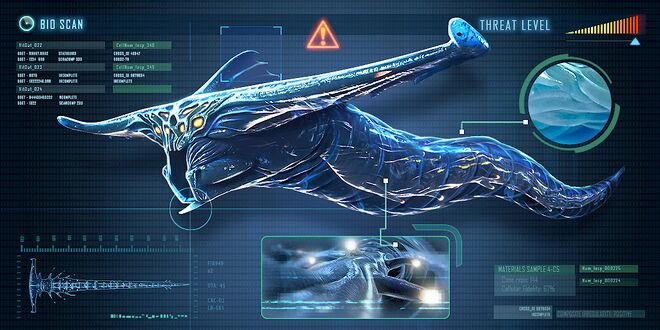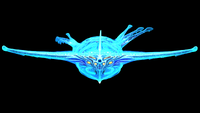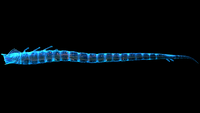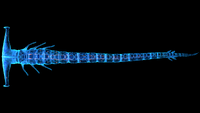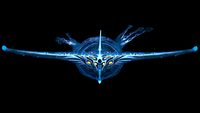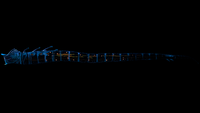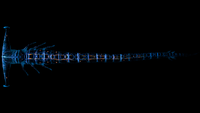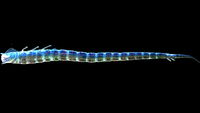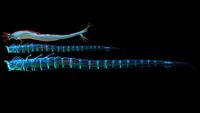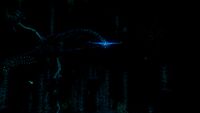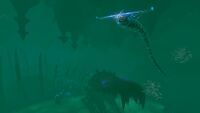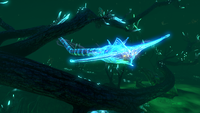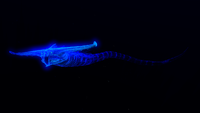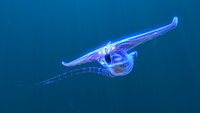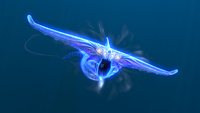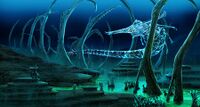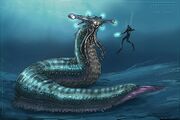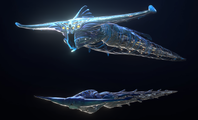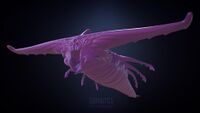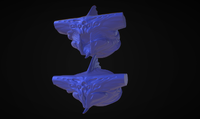Ghost Leviathan: Difference between revisions
No edit summary |
m (Grammar and conciseness? Is that a word?) |
||
| Line 26: | Line 26: | ||
67 meters (Juvenile) |
67 meters (Juvenile) |
||
|debugspawn = ''ghostleviathan'' ''ghostleviathanjuvenile'' |
|debugspawn = ''ghostleviathan'' ''ghostleviathanjuvenile'' |
||
}}The '''Ghost Leviathan''' is a [[Leviathan Class Organisms|leviathan class]] life form belonging to the [[fauna]] category. It is the second largest aggressive creature of ''Subnautica'' ( |
}}The '''Ghost Leviathan''' is a [[Leviathan Class Organisms|leviathan class]] life form belonging to the [[fauna]] category. It is the second largest aggressive creature of ''Subnautica'' (the largest being the [[Sea Dragon Leviathan]] and the third being the [[Reaper Leviathan]]) and the third largest of all of the fauna. |
||
Six Ghost Leviathans spawn on the map (not counting the three found in the [[Crater Edge]]): three juveniles in the [[Lost River]], two adults in the [[Grand Reef]], and one adult in the [[Blood Kelp Zone|Northern Blood Kelp Zone]]. |
Six Ghost Leviathans spawn on the map (not counting the three found in the [[Crater Edge]]): three juveniles in the [[Lost River]], two adults in the [[Grand Reef]], and one adult in the [[Blood Kelp Zone|Northern Blood Kelp Zone]]. |
||
| Line 34: | Line 36: | ||
The [[Giant Cove Tree]] is the nesting ground of this leviathan species (although they are not present around the tree), with its massive glowing bulbs being their eggs which are blue and purple. According to PDA scan entries of the Cove Tree, the eggs were laid there when the tree was small, and the branches have grown around the eggs to protect them until conditions are right to hatch. |
The [[Giant Cove Tree]] is the nesting ground of this leviathan species (although they are not present around the tree), with its massive glowing bulbs being their eggs which are blue and purple. According to PDA scan entries of the Cove Tree, the eggs were laid there when the tree was small, and the branches have grown around the eggs to protect them until conditions are right to hatch. |
||
The Ghost Leviathans' life cycle begins in the Lost River as juveniles, they consume the [[Ghostray|Ghostrays]] and [[River Prowler|River Prowlers]]. As the leviathans mature and become too large for their home, they migrate to the open, surface world biomes such as the [[Grand Reef]] and [[Blood Kelp Zone]], consuming [[Ampeel|Ampeels]] and [[Crabsquid|Crabsquids]] in the Northern Blood Kelp, and shoals of fish and possibly even [[Sea Treader Leviathan|Sea Treader Leviathans]] in the Grand Reef, until eventually migrating to the [[Crater Edge]], roaming freely in the open water and constantly growing larger until they die.<ref name="GR">http://imgur.com/pqiy0N6</ref><ref>http://imgur.com/8QBPgcc ''Dated July 6, 2017.''</ref> Despite being much smaller than the [[Sea Emperor Leviathan]], the Ghost Leviathan's eggs can be far larger, capable of growing to sizes far too large for the creature to lay, suggesting the eggs can grow |
The Ghost Leviathans' life cycle begins in the Lost River as juveniles, they consume the [[Ghostray|Ghostrays]] and [[River Prowler|River Prowlers]]. As the leviathans mature and become too large for their home, they migrate to the open, surface world biomes such as the [[Grand Reef]] and [[Blood Kelp Zone]], consuming [[Ampeel|Ampeels]] and [[Crabsquid|Crabsquids]] in the Northern Blood Kelp, and shoals of fish and possibly even [[Sea Treader Leviathan|Sea Treader Leviathans]] in the Grand Reef, until eventually migrating to the [[Crater Edge]], roaming freely in the open water and constantly growing larger until they die.<ref name="GR">http://imgur.com/pqiy0N6</ref><ref>http://imgur.com/8QBPgcc ''Dated July 6, 2017.''</ref> Despite being much smaller than the [[Sea Emperor Leviathan]], the Ghost Leviathan's eggs can be far larger, capable of growing to sizes far too large for the creature to lay, suggesting that the eggs can grow after being laid. Since the Ghost Leviathans in the Crater Edge are able to survive there, it is pretty much confirmed that Ghost Leviathans can feed off of microscopic organisms. |
||
==Appearance== |
==Appearance== |
||
| Line 103: | Line 105: | ||
GL Dorsal Night.png|Bioluminescence, dorsal view |
GL Dorsal Night.png|Bioluminescence, dorsal view |
||
GL Sizeref.png|The size of an adult Ghost Leviathan compared to the [[Player]] |
GL Sizeref.png|The size of an adult Ghost Leviathan compared to the [[Player]] |
||
SomeSNEKS.JPG|Size comparison between an adult Ghost Leviathan, |
SomeSNEKS.JPG|Size comparison between an adult and a juvenile Ghost Leviathan, as well as a [[Reaper Leviathan]] |
||
NBKGL.jpg|The adult Ghost Leviathan in the Northern Blood Kelp Zone at night |
NBKGL.jpg|The adult Ghost Leviathan in the Northern Blood Kelp Zone at night |
||
GL BF.jpg|The juvenile Ghost Leviathan found in the Bones Field |
GL BF.jpg|The juvenile Ghost Leviathan found in the Bones Field |
||
| Line 135: | Line 137: | ||
== Trivia == |
== Trivia == |
||
* The adult Ghost Leviathans found in the void are roughly 1.15x as large as the adults that are found in the crater. |
* The adult Ghost Leviathans found in the void are roughly 1.15x as large as the adults that are found in the crater. It is possible that this is due to simply growing too large after living for enough time. |
||
== References == |
== References == |
||
Revision as of 04:55, 20 March 2021
<infobox>
<title source="title1" style="font-weight:bold; text-align:center;"> <default>Ghost Leviathan</default> </title> <image source="image1">
</image> <label>Category</label> <label>Tab</label> <label>Description</label> <label>Affiliation</label> <format></format> <label>Age</label> <label>Description when cooked</label> <label>Description when cured</label> <label>Inhabit</label> <label>Attitude</label> <label>Health</label> <label>Damage</label> <label>Adult Damage</label> <label>Juvenile Damage</label> <label>Drops</label> <label>Perks</label> <label>Biome</label> <label>Active During</label> <label>Size</label> <label>Length</label> <label>Bioreactor</label> <label>DNA</label> <label>Voice Actor</label>
<label>Debug Spawn</label> <format>- {{#explode:ghostleviathan ghostleviathanjuvenile||0}}
- {{#explode:ghostleviathan ghostleviathanjuvenile||1}}
- {{#explode:ghostleviathan ghostleviathanjuvenile||2}}
- {{#explode:ghostleviathan ghostleviathanjuvenile||3}}
- {{#explode:{{{item_id}}}||0}}
- {{#explode:{{{item_id}}}||1}}
- {{#explode:{{{item_id}}}||2}}
- {{#explode:{{{item_id}}}||3}}
<group layout="horizontal"> <header>Food & Water</header> <label>Food</label> <label>H2O</label> <label>O2</label> </group> <group collapse="open" class="tab-eggs"> <header>Egg</header> <image source="image2"> </image> <label>Tab</label> <label>Description</label> <label>Biome</label> <label>Incubation</label> <label>Bioreactor</label>
<label>Debug Spawn</label> <format>- {{#explode:{{{debugspawn2}}}||0}}
- {{#explode:{{{debugspawn2}}}||1}}
- {{#explode:{{{debugspawn2}}}||2}}
- {{#explode:{{{debugspawn2}}}||3}}
</group> </infobox> The Ghost Leviathan is a leviathan class life form belonging to the fauna category. It is the second largest aggressive creature of Subnautica (the largest being the Sea Dragon Leviathan and the third being the Reaper Leviathan) and the third largest of all of the fauna. Six Ghost Leviathans spawn on the map (not counting the three found in the Crater Edge): three juveniles in the Lost River, two adults in the Grand Reef, and one adult in the Northern Blood Kelp Zone. If the player enters the Crater Edge, a single adult Ghost Leviathan spawns in. If the player stays in the Crater Edge for thirty seconds, a second Ghost Leviathan will spawn. If the player stays in the area for another thirty seconds, a third and final Ghost Leviathan spawns in. They will all pursue the player until the player returns to the playable area, upon which they will all retreat. The Giant Cove Tree is the nesting ground of this leviathan species (although they are not present around the tree), with its massive glowing bulbs being their eggs which are blue and purple. According to PDA scan entries of the Cove Tree, the eggs were laid there when the tree was small, and the branches have grown around the eggs to protect them until conditions are right to hatch. The Ghost Leviathans' life cycle begins in the Lost River as juveniles, they consume the Ghostrays and River Prowlers. As the leviathans mature and become too large for their home, they migrate to the open, surface world biomes such as the Grand Reef and Blood Kelp Zone, consuming Ampeels and Crabsquids in the Northern Blood Kelp, and shoals of fish and possibly even Sea Treader Leviathans in the Grand Reef, until eventually migrating to the Crater Edge, roaming freely in the open water and constantly growing larger until they die.[1][2] Despite being much smaller than the Sea Emperor Leviathan, the Ghost Leviathan's eggs can be far larger, capable of growing to sizes far too large for the creature to lay, suggesting that the eggs can grow after being laid. Since the Ghost Leviathans in the Crater Edge are able to survive there, it is pretty much confirmed that Ghost Leviathans can feed off of microscopic organisms.
Appearance
The Ghost Leviathan has a soft, bioluminescent, transparent outer membrane covering a muscular, blue, inner body which features many darker blue stripes, 12 yellow, bioluminescent eyes as well as six, possibly vestigial fins on the torso section. A small, decorative sail sits on top of the head, and two long structures protruding from either side of its head which bear similarities to the cephalofoil of a hammerhead shark. It has a rectangular mouth with a glowing barbule lure beneath. Its long body tapers to a point.
The outer body is transparent, making the smaller, inner body visible. The inner body is long and thin, and covered in pulsating, bioluminescent orange stripes with many orange tipped protrusions ending with blinking bioluminescent orange glows. Unlike the outer body, the inner body has a distinct, thin neck joining the head and body. As the leviathan moves through the water, it leaves trails behind it.
Behavior
To attack a target, it will spiral up and charge. When charging, it will open up its mouth and make a loud, echoing screech. If it successfully attacks, it will do 84% damage to the player and swim some distance away, as if losing interest.
Adults are able to push the Cyclops and either drag it, or overturn it. If the player is walking around the Cyclops when the Adult begins to push (for example, if they are trying to put out fires caused by an attack), and the Leviathan rolls the submarine over, the player can be killed instantly upon colliding with the walls or ceiling. When killed the Ghost Leviathans that are within the Crater do not respawn, however the adults that reside within the Crater Edge will continue to respawn.
Audio
Data Bank Entries
<tabber> Ghost Leviathan=
|
This creature is approaching the size limit for sustainable organic lifeforms, and has been designated leviathan class. Adults of the species have been encountered exclusively around the edges of the volcanic crater which supports life on this part of the planet, and react with extreme aggression on approach. 1. Hammerhead: 2. Jaws: 3. Torso: 4. Lifecycle: Assessment: Extreme threat - Avoid the crater edge |
|-| Ghost Leviathan Juvenile=
|
This large predator has adapted to live in deep waters and dark cave systems, attacking anything and everything in its quest to grow larger. 1. Torso: 2. Diet: Assessment: Avoid |
</tabber>
Gallery
<tabber> Screenshots=
The size of an adult Ghost Leviathan compared to the Player
Size comparison between an adult and a juvenile Ghost Leviathan, as well as a Reaper Leviathan
The juvenile found in the Ghost Forest
An adult Ghost Leviathan in the Grand Reef at night
A Ghost Leviathan in the Crater Edge
|-| Videos=
- SN GhostLeviathan 03
Ghost Leviathan FX
|-| Concept Art=
|-| Models=
Models from Sketchfab
Highpoly model from Sketchfab
Highpoly head model from Sketchfab
Lowpoly model from Sketchfab
</tabber>
Trivia
- The adult Ghost Leviathans found in the void are roughly 1.15x as large as the adults that are found in the crater. It is possible that this is due to simply growing too large after living for enough time.
References
- ↑ http://imgur.com/pqiy0N6
- ↑ http://imgur.com/8QBPgcc Dated July 6, 2017.
Lua error in package.lua at line 80: module 'Dev:Navbox' not found.

